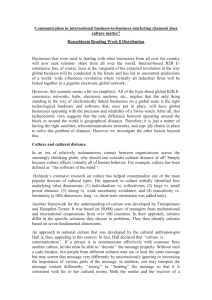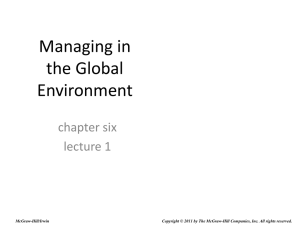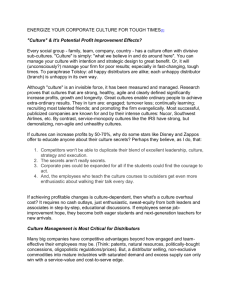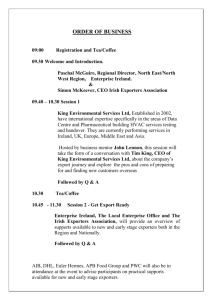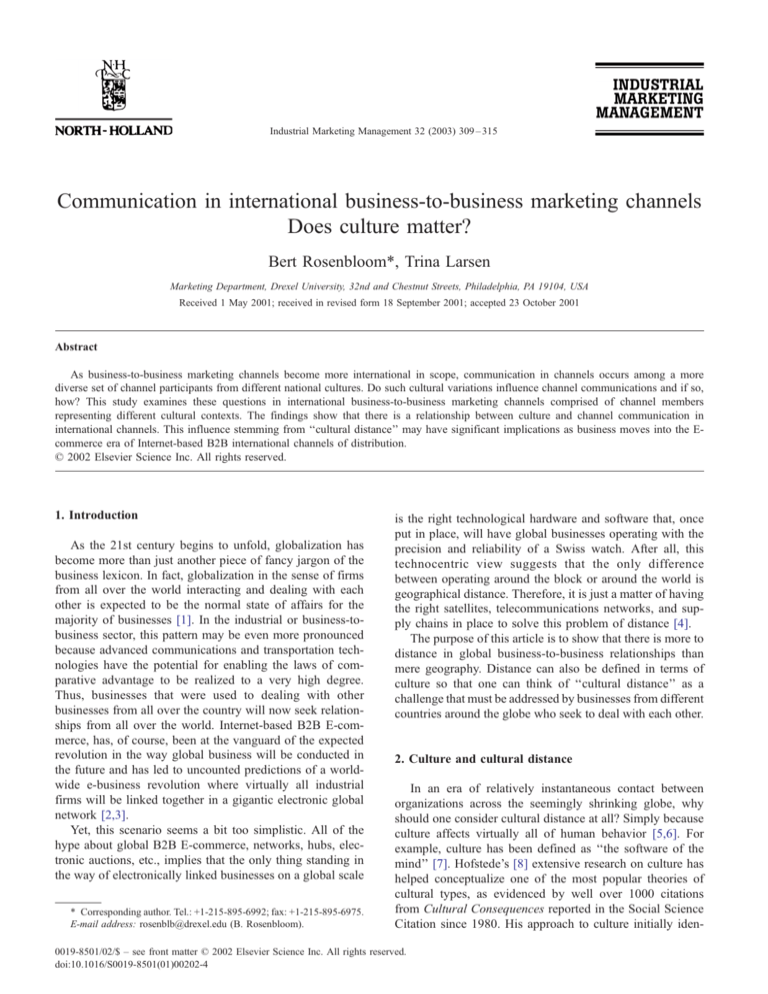
Industrial Marketing Management 32 (2003) 309 – 315
Communication in international business-to-business marketing channels
Does culture matter?
Bert Rosenbloom*, Trina Larsen
Marketing Department, Drexel University, 32nd and Chestnut Streets, Philadelphia, PA 19104, USA
Received 1 May 2001; received in revised form 18 September 2001; accepted 23 October 2001
Abstract
As business-to-business marketing channels become more international in scope, communication in channels occurs among a more
diverse set of channel participants from different national cultures. Do such cultural variations influence channel communications and if so,
how? This study examines these questions in international business-to-business marketing channels comprised of channel members
representing different cultural contexts. The findings show that there is a relationship between culture and channel communication in
international channels. This influence stemming from ‘‘cultural distance’’ may have significant implications as business moves into the Ecommerce era of Internet-based B2B international channels of distribution.
D 2002 Elsevier Science Inc. All rights reserved.
1. Introduction
As the 21st century begins to unfold, globalization has
become more than just another piece of fancy jargon of the
business lexicon. In fact, globalization in the sense of firms
from all over the world interacting and dealing with each
other is expected to be the normal state of affairs for the
majority of businesses [1]. In the industrial or business-tobusiness sector, this pattern may be even more pronounced
because advanced communications and transportation technologies have the potential for enabling the laws of comparative advantage to be realized to a very high degree.
Thus, businesses that were used to dealing with other
businesses from all over the country will now seek relationships from all over the world. Internet-based B2B E-commerce, has, of course, been at the vanguard of the expected
revolution in the way global business will be conducted in
the future and has led to uncounted predictions of a worldwide e-business revolution where virtually all industrial
firms will be linked together in a gigantic electronic global
network [2,3].
Yet, this scenario seems a bit too simplistic. All of the
hype about global B2B E-commerce, networks, hubs, electronic auctions, etc., implies that the only thing standing in
the way of electronically linked businesses on a global scale
* Corresponding author. Tel.: +1-215-895-6992; fax: +1-215-895-6975.
E-mail address: rosenblb@drexel.edu (B. Rosenbloom).
is the right technological hardware and software that, once
put in place, will have global businesses operating with the
precision and reliability of a Swiss watch. After all, this
technocentric view suggests that the only difference
between operating around the block or around the world is
geographical distance. Therefore, it is just a matter of having
the right satellites, telecommunications networks, and supply chains in place to solve this problem of distance [4].
The purpose of this article is to show that there is more to
distance in global business-to-business relationships than
mere geography. Distance can also be defined in terms of
culture so that one can think of ‘‘cultural distance’’ as a
challenge that must be addressed by businesses from different
countries around the globe who seek to deal with each other.
2. Culture and cultural distance
In an era of relatively instantaneous contact between
organizations across the seemingly shrinking globe, why
should one consider cultural distance at all? Simply because
culture affects virtually all of human behavior [5,6]. For
example, culture has been defined as ‘‘the software of the
mind’’ [7]. Hofstede’s [8] extensive research on culture has
helped conceptualize one of the most popular theories of
cultural types, as evidenced by well over 1000 citations
from Cultural Consequences reported in the Social Science
Citation since 1980. His approach to culture initially iden-
0019-8501/02/$ – see front matter D 2002 Elsevier Science Inc. All rights reserved.
doi:10.1016/S0019-8501(01)00202-4
310
B. Rosenbloom, T. Larsen / Industrial Marketing Management 32 (2003) 309–315
tified four underlying value dimensions: (1) individualism
vs. collectivism, (2) large vs. small power distance, (3)
strong vs. weak uncertainty avoidance, and (4) masculinity
vs. femininity (a fifth dimension, long- vs. short-term
orientation was added later).
Another framework for the understanding of culture was
developed by Trompenaars and Hampden-Turner [9]. It was
based on 50,000 cases of managers from multinational and
international corporations from over 100 countries. In their
approach, cultures differ in the specific solutions they
choose to problems. They then identify cultures based on
seven fundamental dimensions. Their approach is similar in
some respects to Hofstede’s dimensions.
While the above approaches are relevant to the development of many types of managerial strategies and tactics,
this study is concerned specifically with communication
issues. An approach to national culture that was developed
by the cultural anthropologist Hall is, thus, appealing in this
context [10 – 12]. In fact, Hall declared that ‘‘culture is
communication’’ [12]. If a person is to communicate effectively with someone from another culture, he/she must be
able to ‘‘decode’’ the message properly. Without such a
code-breaker, two people from different cultures may see or
hear the same message but may screen that message very
differently by unconsciously ignoring or increasing the
importance of various parts of the message. In addition,
one may interpret the message content differently, ‘‘seeing’’
or ‘‘hearing’’ the message so that it is consistent with his or
her cultural norms. Both the sender and the receiver of a
message are products of their own fields of reference or
expertise, that is, the sender has been socialized given his or
her own external cultural environment, as has the receiver.
The less these two fields of experience or reference overlap,
the more ‘‘distant’’ one person’s cultural background is from
another’s, and the more difficult clear communication and
understanding is between the two [13].
Hall’s low- (LC) and high-context (HC) dichotomy
provides a simple two-category basis for grouping the
cultures of many different countries to help understand the
hidden codes in communication. In his framework, in LC
cultures, most of the information flowing between sender
and receiver is contained in the message itself. Consequently, the message needs to be explicit and detailed
because each party will rely almost solely on the information contained in the message itself. On the other hand, in an
HC culture, less explicit and detailed information is carried
in the message itself. Instead, the sender and receiver rely
more on the context of the communication process to
convey the message. Consequently, the human element
and personal relationships tend to play a much larger role
in communication in HC cultures. The cultural context (HC
vs. LC), therefore, may have an impact on how many
messages are sent between marketing channel partners to
achieve effective communication (frequency of communication) as well as the type, or form, of the messages
themselves. Commonly cited examples of countries charac-
Table 1
Countries categorized as low context and high context
Low-context countries
High-context countries
Australia
Austria
Belgium
Britain
Canada
France
Germany
New Zealand
Argentina
Brazil
China
Israel
Italy
Japan
Korea
Mexico
Spain
Turkey
terized by LC cultures are the United States, Germany, and
Switzerland. Examples of countries with HC cultures
include Brazil, Japan, and Mexico (see Table 1).
Communication issues have been extensively researched
by business scholars and the link between culture and
communication has been reviewed [14], yet most efforts
addressing the importance of communication across cultures
have been primarily conceptual. It is accepted that it is an
important facet of marketing channels [15] and effective
communication in marketing channels is difficult enough to
achieve in domestic marketing channels where culture is
relatively homogeneous. Therefore, this paper addresses the
question, does greater cultural distance make even more of a
difference in how channel partners communicate in international marketing channels?
3. Hypotheses
As long as channel members from LC or HC cultures
deal with foreign marketing channel partners from similar
LC or HC cultures, the cultural distance between the two
will be relatively small and, hence, few communication
problems based on cultural distance are likely to appear in
the marketing channel. However, as is so often the case in
international business, marketing channel partners often
come from both LC and HC cultures (e.g. the US and
Brazil, the US and Japan, the US and Mexico). Thus, the
cultural distance may be relatively large and may become a
crucial issue in developing an effective and efficient flow of
communication in international channels of distribution. For
example, what may appear to be a routine E-mail concerning a delivery date from an LC channel participant in the US
to an HC participant in Japan may not be so routine at all if
the Japanese partner does not feel comfortable with the terse
style of the E-mail format so commonly used by LC US
firms. Indeed, if the Japanese channel participant has not
already established a person-to-person relationship whereby
the relevant executives from each firm have met each other
on a face-to-face basis, little regard or trust may be placed in
the E-mail message by the Japanese recipient. Such culturally based discomfort with or even lack of trust in formal
B. Rosenbloom, T. Larsen / Industrial Marketing Management 32 (2003) 309–315
communications among firms participating in marketing
channels consisting of firms from LC and HC cultures
may elicit actions aimed at ameliorating the cultural distance
by the HC channel partner. For example, the Japanese firm
may ask the US firm to ‘‘clarify’’ the E-mail via phone calls,
faxes, or letters to augment the original E-mail communication. In fact, a whole series of back and forth communication via phone, fax, and letters may be needed to help
reduce the cultural distance between the LC US channel
partner and its HC Japanese counterpart. As a result,
marketing channel members from one culture may require
much more frequent messages to effectively communicate
with their channel partner than channel members in another
culture in order to reduce cultural distance.
Given this potential relationship between cultural distance and communication in international marketing channels, the following hypotheses are offered:
Hypothesis 1: Fax communication frequency between
international channel partners increases when cultural
distance is large.
Hypothesis 2: Telephone communication frequency between international channel partners increases when cultural
distance is large.
Hypothesis 3: E-mail communication frequency between
international channel partners increases when cultural
distance is large.
Hypothesis 4: Written communication (business letters)
frequency between international channel partners increases
when cultural distance is large.
311
personnel most familiar with their firm’s foreign distributors. In responding to the questionnaire, managers in the
export firms were asked to consider the communication that
they have with only one foreign distribution partner and to
indicate the country of that foreign distributor. Eighteen
nations other than the United States were represented in the
study and they included countries on five continents (see
Table 1).
Communication frequency was assessed by asking the
export managers to indicate the frequency of their communication with the foreign distributor over a period of 4 weeks.
They provided information about how frequently they contacted the foreign distributor via telephone, fax, e-mail, and
written letters. A five-point Likert scale ranging from very
infrequently to very frequently was used to measure
respondents’ perceptions of foreign distributors’ contact
frequency. These respondents also provided information
about how frequently they were contacted by the foreign
distributor via telephone, fax, e-mail, and written letters
using the same five-point Likert scale ranging from very
infrequently to very frequently.
Cultural distance was assessed via Hall’s HC vs. LC
cultural classification. The respondents were asked to indicate the country of origin of the foreign distributor. The
foreign distributors were then classified as either LC or HC
based on Hall’s classification (see Table 1). Since the US is
an LC culture, when US exporters interact with foreign
distributors from another LC culture, they are operating in a
small cultural distance situation. On the other hand, when
LC US exporters interact with foreign distributors from an
HC culture, they are operating in a large cultural distance
situation.
4. Methodology
5. Findings
To explore the impact of cultural distance on communication in international marketing channels, a study of
communication between US exporters and their distributors
in foreign countries was undertaken. Since all of the
exporters in the study were US-based, by definition they
are all LC. However, to assess the effect of cultural distance
on communication in the exporter – distributor marketing
channel, foreign distributors from a wide variety of countries around the globe were sought. A source list of US
exporters operating throughout the world was obtained from
a reputable business directory publisher. Executives at each
export firm were contacted by telephone to request their
participation in the study. Of 250 firms contacted, 60 firms
agreed to participate. Approximately 2 weeks after the initial
contact, nonrespondents were contacted again via telephone
to encourage their participation. Six of the returned surveys
were discarded due to incompleteness, resulting in a 21.6%
response rate. Of the 54 cases used for the analyses, 35
included foreign distributors from high cultural context
countries and 19 were from low cultural context countries.
Contacts included senior managers and other qualified
In order to provide the highest level of sensitivity
possible for measuring respondents’ perception of how
frequently they needed to communicate due to cultural
distance, only the very frequently category is reported here.
By focusing on the exporters’ responses at this very high
level of communication frequency, the chance of including
what might be considered ‘‘normal’’ everyday communication between the US exporters and their foreign distributors
is minimized.
The following sections report the findings for communication via fax, telephone, E-mail, and written letters.
Graphs of the responses at the very frequent level (5 on a
1 –5 Likert scale) are presented in Figs. 1– 4. Fig. 1 shows
fax communication, Fig. 2 phone communication, Fig. 3 email communication, and Fig. 4 written communication.
5.1. Fax communication and cultural distance
Hypothesis 1 was supported. When communicating with
their foreign distributors, US exporters were much more
312
B. Rosenbloom, T. Larsen / Industrial Marketing Management 32 (2003) 309–315
Fig. 1. T-test for US exporter initiated is significant at .05. T-test for foreign distributor initiated is significant at .05.
likely to report both initiating and receiving communication
via fax at the very frequent level when the cultural distance
between them and their foreign distributor was large than
when it was small. Specifically, when the cultural distance
was large, 77.1% of the US exporters initiated fax communication with their foreign distributors very frequently
and 71.4% of the foreign distributors initiated fax communication with the US exporters very frequently. The corresponding percentages for fax communication with their small
cultural distance foreign distributors were 29.4% and
41.2%, respectively. Clearly, there was a great deal more
faxing back and forth with the foreign distributor when that
foreign distributor was from a culturally distant country.
5.2. Telephone communication and cultural distance
Hypothesis 2 was supported. When examining phone
communication, similar results were observed. As shown in
Fig. 2. T-test for US initiated is significant at .05. T-test for foreign distributor initiated is significant at .10.
B. Rosenbloom, T. Larsen / Industrial Marketing Management 32 (2003) 309–315
313
Fig 3. T-test for US exporter initiated is not significant. T-test for foreign distributor initiated is not significant.
Fig. 2, some 40% of the US exporters initiated phone
communication with their foreign distributors from culturally distant countries very frequently, while their foreign
distributors from culturally distant countries initiated communication by phone 34.4% of the time very frequently. US
exporters only initiated phone communication with their
small cultural distance foreign distributors very frequently
11.8% of the time, and those foreign distributors initiated
phone communication very frequently only 17.6% of the
time. Once again, US exporters engaged in very frequent
communication back and forth with culturally distant foreign distributors much more so than with culturally close
foreign distributors.
5.3. E-mail communication and cultural distance
Hypothesis 3 was not supported. E-mail communication
frequency presented a very different picture. Frequency was
much higher in the small cultural distance context than in the
large cultural distance context. Over 23% of US exporters
Fig. 4. T-test for US exporter initiated is not significant. T-test for foreign distributor initiated is not significant.
314
B. Rosenbloom, T. Larsen / Industrial Marketing Management 32 (2003) 309–315
initiated e-mail communication with small cultural distance
foreign distributors very frequently, but less than 6% did so
with their large cultural distance counterparts. In addition,
41.2% of small cultural distance foreign distributors initiated
e-mail contact at the very frequently level as opposed to only
17.1% of large cultural distance distributors doing so.
This seemingly opposite result for e-mail compared with
the findings for communication frequency via fax and
telephone probably reflects the nature of e-mail as an
inherently LC mode of communication. The very terse
and abbreviated style typical of e-mail communication
allows little room for explanation or nuance. Thus, in the
case of large cultural distance, unlike fax or telephone, email is apparently not viewed as an effective medium for
augmenting the flow of communication in HC international
marketing channels.
5.4. Written communication and cultural distance
Hypothesis 4 was not supported. Written letters were not
used very frequently by US exports or their foreign distributors, regardless of the cultural distance separating the two
parties. Written letters appear to be somewhat obsolete when
compared with the other modes of communication. Only
5.7% of US exporters very frequently initiated communication with their culturally distant foreign distributors and only
5.9% with their culturally close foreign distributors. Foreign
distributors likewise did not initiate written communication
very frequently with the US exporters. However, the percentage initiating written communication from culturally
close nations was almost double that of those from culturally distant nations. Almost 12% of foreign distributors from
nations with a small cultural distance from the US initiated
written communication with their US exporters, while 5.7%
from large cultural distance nations did so. Therefore, while
the numbers of foreign distributors choosing written letters
as a communication mode very frequently was not high,
when the parties involved were both from LC cultures, they
engaged in written communication almost twice as often as
HC distributors did with their culturally distant LC US
exporter counterparts. This is consistent with the expectations of LC cultures that encode more of the meaning of
their communication in the actual words of a message than
do people from HC cultures.
6. Discussion and conclusions
Much of the promise of B2B e-commerce on a global
scale is dependent upon the efficiency that can theoretically
be gained by electronically linked channel participants [2].
Thus, instead of intensive communications between people
at all levels of the marketing channel contacting each other
to make sure that the right products are moving through
international channels at the right place and time, Internetbased e-commerce would replace all of these people-cen-
tered communication processes. In short, communication
among channel participants would be computer-to-computer
not person-to-person in the international B2B e-commerce
scenario. Once such electronic networks are in place, with
the appropriate electronic marketplace architecture and B2B
software, smooth and continuous flows of products from
any given country to another would occur ‘‘automatically’’
based on virtually perfect flows of communication through
the electronic networks [3]. In such a world, good communication is dependent solely on having the right technology in place to traverse the distances separating channel
participants in different countries. Variations among nations,
and their peoples stemming from different cultures would be
irrelevant in such a scenario. Cultural distance, if it exists,
would be erased by the awesome power of the Internet.
Our exploratory study of communication in international
marketing channels suggests that such a scenario may be
overly optimistic and naive if substantial ‘‘cultural distance’’
exists among international channel participants. Indeed,
when the exporters from the LC US culture dealt with
foreign distributors from HC cultures, ‘‘old fashioned’’ fax
and telephone communication took place much more frequently than when the US exporters dealt with foreign
distributors from LC cultures. Moreover, the more ‘‘modern’’ e-mail communications between US exporters and
foreign distributors took place more frequently when both
exporter and foreign distributor were from LC cultures,
reflecting the limitations of the terse style of e-mail to fill
in the gaps in communication between channel members
from different cultural contexts.
Of course, in this study, the US exporters and their
foreign distributors were not yet part of an Internet-based
electronic network. They were linked only in the sense of
having established trading relationships in conventional
channels of distribution. Thus, one might argue that if these
same firms were to become part of a B2B e-commerce
network their communication patterns would automatically
change. Exporters and foreign distributors frequently reaching for the phone or constantly turning to the fax machine to
clarify communications when cultural distance is high
would, therefore, quickly cease. Frankly, it is doubtful that
such would be the case. Indeed, the need to augment the
totally impersonal electronic communications flowing over
the Internet via ‘‘old fashioned’’ but more comfortable
modes of communications might be greater than ever in
the new electronic marketing channels. The need to ask
questions, get clarifications, and reassurances so as to
achieve a acceptable comfort level will not suddenly disappear for channel members from HC cultures simply
because they are electronically linked to a network [16].
6.1. Managerial implications
The study does not indicate that cultural distance will be
a drastic impediment to the application of electronic technology to international marketing channels. It does suggest,
B. Rosenbloom, T. Larsen / Industrial Marketing Management 32 (2003) 309–315
however, that cultural distance does affect communication
in international marketing channels by fostering the need for
more human involvement in channel communications. This
should be taken into account in the planning and development of international business-to-business marketing
channels that must span the distance between LC and HC
cultures. Consequently, executives responsible for managing
international channels in situations where cultural distance
is large may expect to be called on relatively frequently to
help clarify and expedite channel communications. And,
even in the age of advanced communications technology,
managers will often have to utilize such ‘‘old fashioned’’
means as the telephone and fax machine to do so.
References
[1] Czinkota MR, Ronkainen I, Moffett MH, Moynihan EO. Global business. 3rd ed. Harcourt College Publishers; 2001.
[2] Nakache P. What you need to know about purchasing online. Harv
Manage Update (July 3 – 5).
[3] Kaplan S, Sawhney M. E-hubs: the new B2B marketplaces. Harv
Bus Rev 2000;97 – 110 (May – June).
[4] Moon Y. Network technology and the role of intermediaries. Harv Bus
Sch Note (January 19).
[5] Terpstra V, David K. The cultural environment of international business. 2nd ed. South-Western Publishing; 1985.
315
[6] Ferraro GP. The culture dimension of international business. 2nd ed.
Englewood Cliffs, NJ: Prentice-Hall; 1994.
[7] Hofstede G. Culture and organizations: software of the mind. Berkshire, UK: McGraw-Hill; 1991.
[8] Hofstede G. Culture’s consequences. Beverly Hills, CA: Sage; 1980.
[9] Trompenaars F, Hampden-Turner C. Riding the waves of culture. 2nd
ed. New York: McGraw-Hill; 1998.
[10] Hall ET. Beyond culture. Garden City, NY: Anchor Press/Doubleday; 1977.
[11] Hall ET. Hidden differences: studies in international communication.
Hamburg: Grunner & Jahr; 1983.
[12] Hall ET, Hall MR. Understanding cultural differences. Yarmouth,
ME: Intercultural Press; 1990.
[13] Triandis H, Albert R. Cross-cultural perspectives. In: Jablin F, et al,
editors. Handbook of organizational communication: an interdisciplinary perspective. Newbury Park, CA: Sage Publications; 1987.
p. 264 – 96.
[14] Samovar LA, Porter PE, Jain NC. Understanding intercultural communication. Belmont, CA: Wadsworth; 1981.
[15] Mohr J, Nevin J. Communication strategies in marketing channels: a
theoretical perspective. J Mark 1990;50:36 – 51.
[16] Evans P, Wurster TS. Getting real about virtual commerce. Harv Bus
Rev 1999;85 – 94 (November – December).
Bert Rosenbloom is Professor of Marketing and the Rauth Chair of
Electronic Commerce Management at Drexel University in Philadelphia,
PA.
Trina Larsen Andras is Professor and Head of the Marketing Department
at Drexel University in Philadelphia, PA.

